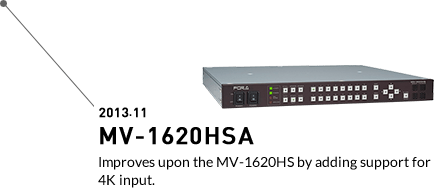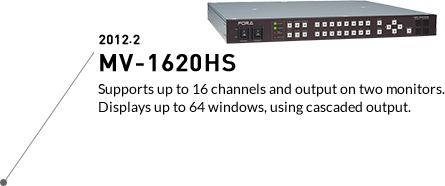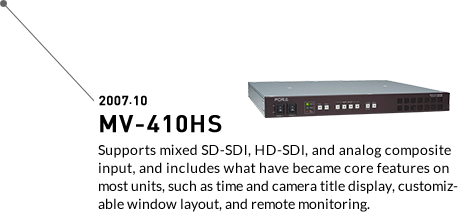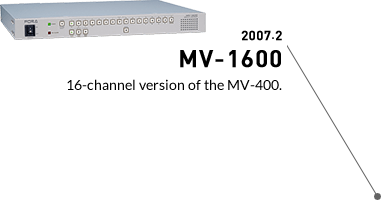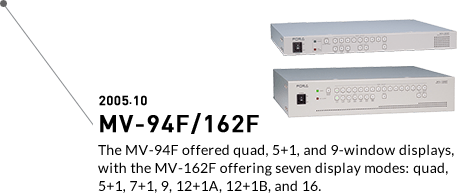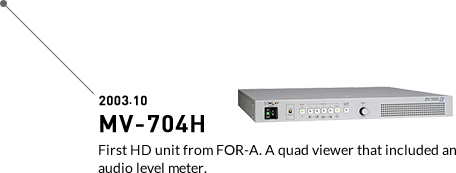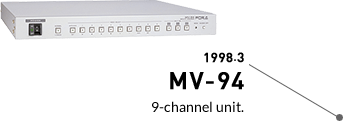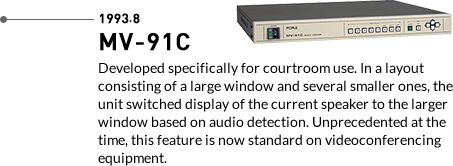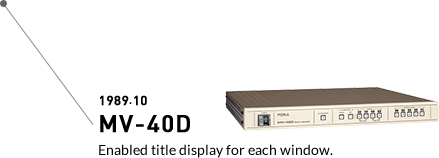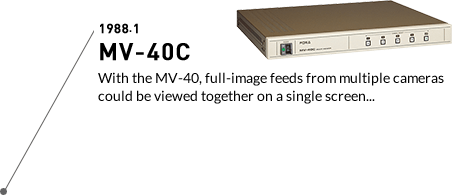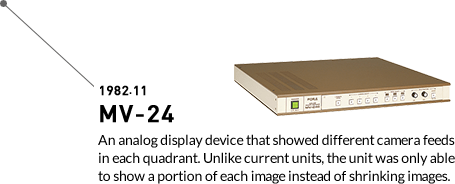Monitors network camera images without a PC
The MV-16SIP network multi-viewer inputs video from security IP cameras (compatible with ONVIF® standard) and provides split display via HDMI. The date and time as well as titles can be added for each camera image. Once set up, IP camera images can be monitored in stores and other facilities without installing a PC. Optional analog composite I/O and SDI output, as well as analog audio, can be added. Analog camera images can be displayed in combination with IP camera images.

Extreme connectivity in multiple inputs and outputs
Takes the acclaimed multi-I/O approach of the MV-3200 a step further with broad format support, including 4K. Unmatched specifications: up to 68 inputs, with 8-monitor/114-window output. Simplifies 4K workflows by accepting a variety of mixed input. As with past units, layouts for each output can be freely customized. Series are available in two sizes—the 2RU MV-4200 and 3RU MV-4300—and each includes models featuring either SDI or HDMI/SDI output. A model is also available for input and output of next-gen 12G-SDI signals.

Mixed display: SD, HD, analog, and computers
FOR-A enjoyed greater presence in the midrange market for the broadcast industry thanks to the MV-1600HS. In the evolution of this popular approach—allowing users to configure units as they wish, with input cards—the next unit would be compatible with even larger systems and display up to 32 windows. The engineers insisted on a truly versatile monitoring platform: input of mixed SD, HD, and computer signals, and output on up to four monitors, each individually customizable. This proved a winning combination for centralized monitoring of an array of feeds, and to this day, the unit remains a key component at many sites, from broadcast and postproduction studios to the large monitoring systems that support social infrastructure.

A model that redefined the product
Not content with the basic screen layout of most early units, with each feed simply assigned to a different quadrant, FOR-A took on development of a new kind of quad viewer. The MV-40F introduced an unprecedented variety of layout options: two windows (tiled vertically or horizontally), three (with one covering half the screen vertically or horizontally), or four, besides PiP with up to three inset windows. With a sales volume of over 10,000 units, the unit remains in widespread use even today, more than 15 years since launch, as a product closely associated with FOR-A.
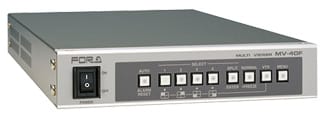
Cutting costs to expand use in many applications
Several brands of 16-channel units were now available, but they were still rather expensive. FOR-A engineers set out halve the cost by applying MV-40E quad viewer technologies. Although a variety of layouts were possible by combining a quad-channel gate array with a 16x16 matrix, analog circuits were required in order to pass signals between the gate arrays. Driving and adjustment were challenging, but eventually, success opened the door for use in many more applications, from cable TV guide channels to surveillance.

The advent of multi-channel viewers
Now that quad viewers had popularized multi-feed monitoring on a single screen, more users began calling for 9- or even 16-window display. First, FOR-A engineers focused on developing a 9-channel unit. Doubling the number of inputs would be no excuse for making a unit twice as large, so the engineers worked to keep it compact. Ultimately, a hybrid input circuit was devised that enabled a unit of the same size.

Coining the word for multi viewers
With the MV-40, full-image feeds from multiple cameras could be viewed together on a single screen. This innovation transformed monitoring by reducing the space and number of monitors needed. Soon, more users called for models that could also display feeds from color cameras. FOR-A worked quickly to meet this need, as more banks, convenience stores, and other businesses installed multiple color security cameras. Without exaggeration, the launch of the MV-40C finally introduced modern monitoring. FOR-A was also the first company to name these devices, which set the standard.








